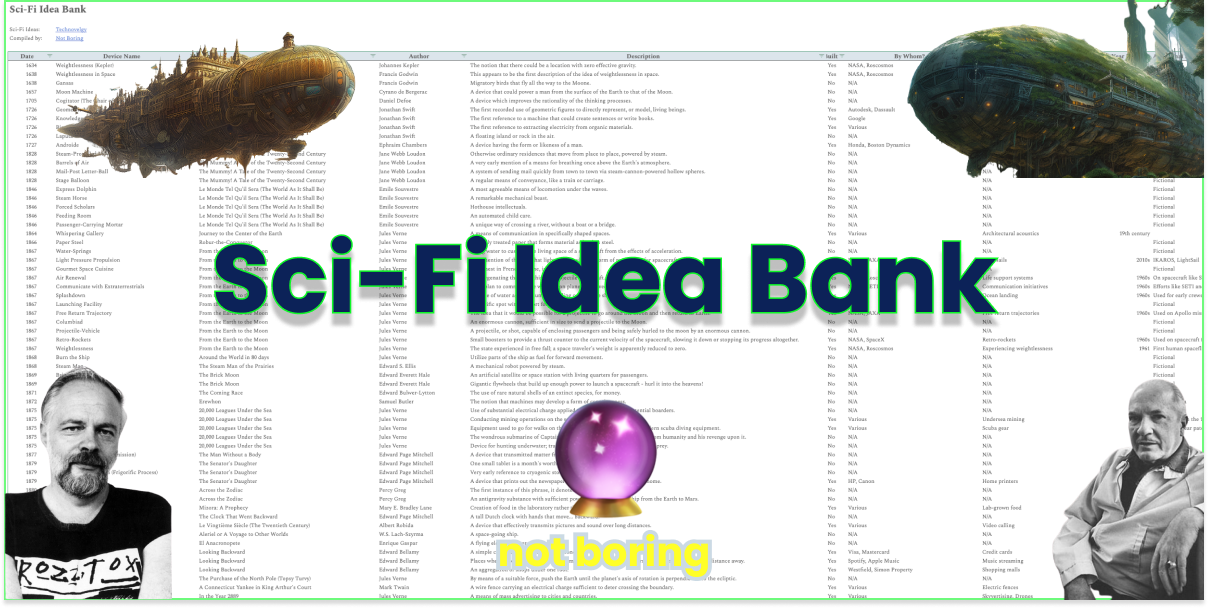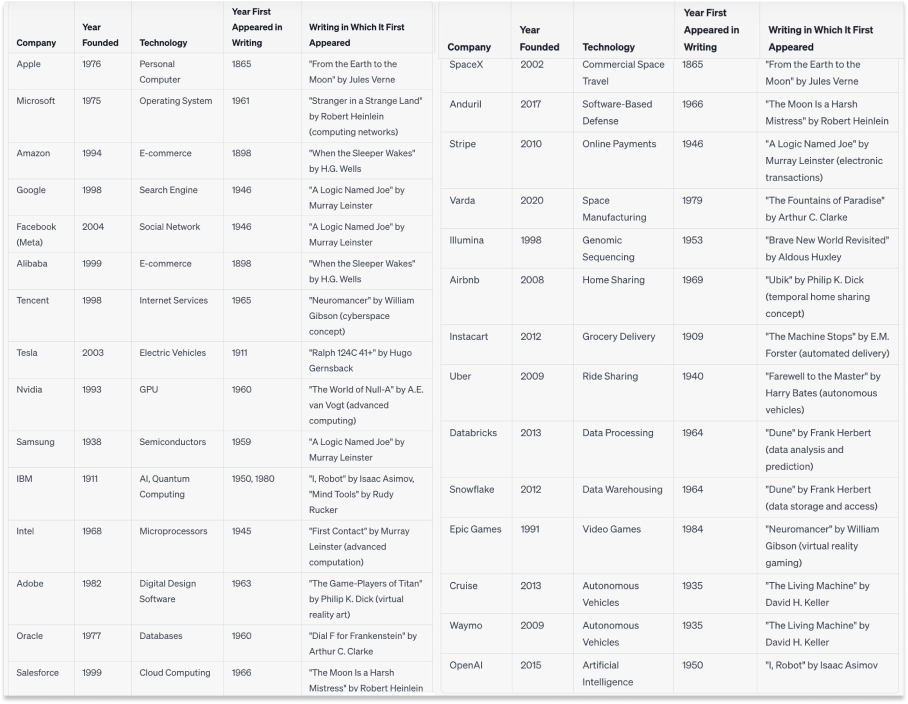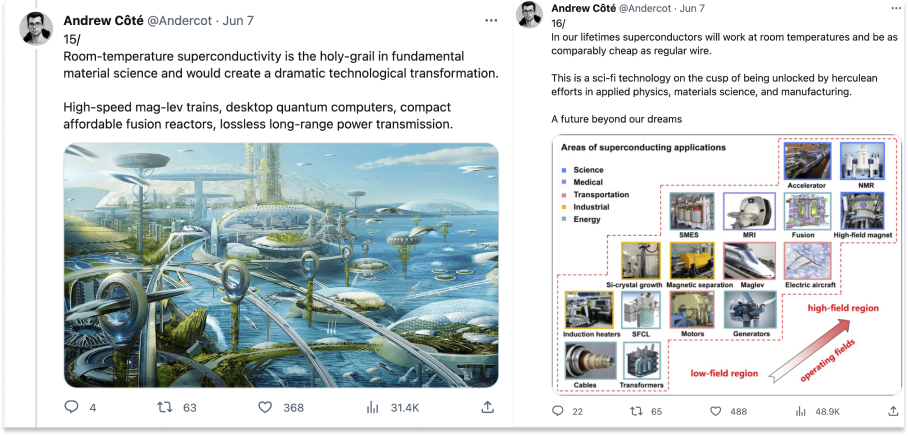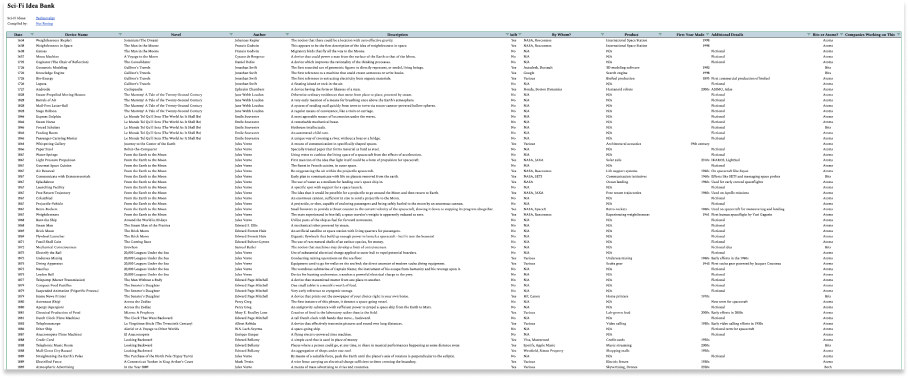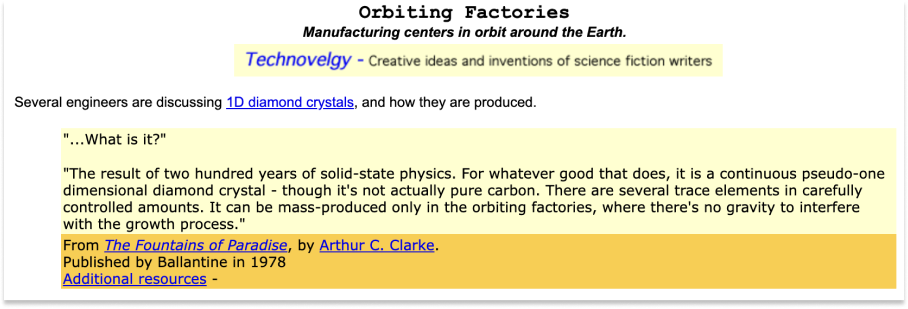Not Boring by Packy McCormick - Sci-Fi Idea Bank
Welcome to the 1,216 newly Not Boring people who have joined us since last Tuesday! If you haven’t subscribed, join 210,510 smart, curious folks by subscribing here: Today’s Not Boring is brought to you by… Percent The alternative asset you probably haven't yet considered: Private credit. While the traditional 60/40 portfolio has fallen short over the past few years, private credit is currently offering double digit yields to investors, while being less-correlated to the market. It’s no wonder Blackstone’s billionaire president Jonathan Gray when discussing private credit last month stated: “I would say whenever you can get equity-like returns taking debt-like risk, that’s something you should do.” While institutional investors have been loading up on private credit for years, this asset class has largely been out of reach for main street investors. But that’s changing thanks to Percent – a frontrunner in private credit investments. Percent offers exclusive private credit deals previously out of reach to most investors. If you’re an accredited investor, you get access to:
Not Boring readers can receive up to a $500 bonus with their first investment. Hi friends 👋, Happy Tuesday! Back in 2021, I tweeted, “The only way to not be totally flummoxed by everything that’s going on right now is to have read a lot of sci-fi.” That’s even more true now than it was then. If you don’t read much sci-fi, the speed of technological progress can seem overwhelming. There are so many new things, and they’re coming so quickly. If you do read a lot of sci-fi, though, your reaction to each new announcement might be: “What took you so long?” One way to look at progress in tech is that we’re just working our way through ideas that sci-fi writers came up with a long time ago. So a bank of those ideas might be a roadmap to the future and a compass for those who want to build the sci-fi futures we were promised. Let’s get to it. Sci-Fi Idea BankOver the weekend, I built a spreadsheet with 3,567 sci-fi ideas, a Sci-Fi Idea Bank, using the best website on the internet and a team of AI research assistants. I hope it can be a starting point for people who want to bring sci-fi to life, because: Ideas for new technologies almost always appear in sci-fi before they show up in real life. Not the exact ideas, of course, but science fiction writers are astonishingly good at sketching the outlines of technologies that will only become possible decades or even centuries in the future. Did you know, for example, that Jonathan Swift foresaw 3D modeling, search engines, biofuels, and even floating rocks in Gulliver’s Travels, way back in 1726? Or that Ephraim Chambers wrote about humanoid robots nearly 300 years ago in 1727’s Cyclopaedia? Or that John Jacob Astor IV, that John Jacob Astor IV, the richest passenger on the Titanic, the “Astor” in “Astor Place,” wrote about rooftop windmills for energy, security cameras, traffic cameras, regenerative braking, electric cars (complete with recharging stations), hydrofoil boats, spaceships, and airlocks in his 1894 book, A Journey in Other Worlds? When Jeff Bezos walked through the logic behind selling books online in this legendary 1997 interview, he looked insanely prescient. But H.G. Wells imagined e-commerce 98 years earlier in When the Sleeper Wakes (and remote work, handheld video players, a proto-internet, and more). It’s hard to find an example of a tech company whose product didn’t appear in sci-fi first. Over the weekend, I asked ChatGPT to make a table of the most valuable tech companies, plus a handful of hand-selected ones, and where the technology they built first showed up in sci-fi. It’s not perfect – even some of the books’ published years are wrong – but it’s directionally correct. The seemingly novel ideas behind the biggest tech companies show up in sci-fi before they’re brought into reality. When you think about it, of course they do. It’s easier to write something down than it is to build it. Ideas precede reality. When a sci-fi writer comes up with an idea, it floats around in latent space, waiting to be pulled down when the necessary underlying technologies finally exist and hit their sweet spot on the cost and performance curves. When the time is right, an inventor or entrepreneur grabs it and tries to wrestle it into the real world. Viewed another way, sci-fi is a goldmine of ideas for startups. There are thousands of ideas waiting to be built when the time is right. And as AI explodes, energy becomes more abundant, space becomes cheaper to access, DNA becomes cheaper to sequence, breakthroughs occur, and any number of curves continue to compound, more ideas, pre-vetted in narrative, get unlocked. I think this explains why everyone got so excited about LK-99. I’m sure that a handful of materials scientists and physicists genuinely cared about room-temperature ambient-pressure superconductivity itself, about the science and the decades-long pursuit in nondescript labs across the globe. Most of us, though, cared for a different reason: room-temperature superconductors unlock a new batch of sci-fi ideas. With room-temperature superconductors, so many ideas locked in the pages of sci-fi novels could be brought to life:
Superconductors or not (and it’s looking like not, for now), we’re bringing sci-fi ideas to life faster than we have in half a century. SpaceX is the most valuable startup in the US. San Francisco just approved Cruise and Waymo for 24/7 service. Varda is manufacturing drugs in space. Nuclear energy’s approval rating is the highest it’s been in a decade and fusion companies are racing to commercialize the power of the sun. All of these companies’ products were predicted in sci-fi. There are many such sci-fi technologies, many of which have yet to be built. Luckily, after I tweeted that sci-fi table, Dan Jeffries replied with a link to the goldmine: Technovelgy. I don’t know how I’d never heard of Technovelgy before. Bill Christensen, who runs the site, is maybe the most criminally underfollowed person on Twitter with only 984 followers on @technovelgy. The website is both a crazy labor of love and an absolute goldmine. On it, there are over 3,000 ideas from sci-fi novels over four centuries – Gravity Neutralizing Disks, Telelubricator, and Multivac, to pick three at random – with quotes and explanations. Once I found it, I got obsessed. I spent more time than I care to admit this weekend on a combination of Technovelgy, ChatGPT, Claude (x2 accounts), Excel, and Google Sheets. I wanted to make a Sci-Fi Idea Bank. The Sci-Fi Idea BankAnd it actually kinda worked! You can check it out and play with it yourself. The Sci-Fi Idea Bank is a spreadsheet of 3,567 sci-fi ideas lovingly pulled from Technovelgy, updated to include whether they’ve been built yet, and if so, when, by whom, and what the product is, plus some additional notes and whether they’re mainly bits or atoms. There are some interesting stats. Like: 26% of ideas have been built, and ideas involving bits (32.4%) were more likely to come true than those involving atoms (23.7%). Or: Philip K. Dick is the GOAT, with 152 ideas on the list, 52 of which have been built. Or: 1931 was a particularly rich year for sci-fi ideas, leading the list with 152 ideas, 52 of which have been built. I bet you could use Code Interpreter to slice and dice the data in more interesting ways:
Filling in the spreadsheet took a process straight out of the pages of sci-fi itself. After fumbling around with ChatGPT (and the BrowserOp Plugin and Code Interpreter) for far longer than I care to admit, I figured out a way to get my AI interns to fill out the sheet. If you want to read about how I did it, check out Building the Sci-Fi Idea Bank. Note: this is still not perfect by any means. There are still formatting issues. Claude missed a bunch of things. There are some things that have been made that it didn’t catch, and I didn’t catch nearly all of its misses. It gave broad credit instead of specific companies and products in a lot of cases. It didn’t categorize bits and atoms the way I would have in some cases. But it’s a start. I’m going to keep cleaning it up. I locked the main sheet, but I added a “Hivemind” sheet that you can edit if you want to help update it, correct it, add color, highlight the startups working on certain sci-fi ideas, or copy it and extend it in any way, and use it to bring sci-fi to life. Sci-Fi Idea Bank as Treasure MapThat last part is the most exciting. If you want, you can take this Idea Bank and add color and context to it. I think one of the most interesting extensions would be to figure out which underlying technologies are required for each idea, how far along they are in their development, and how economically feasible they are. Technical specs and roadmaps for sci-fi ideas. Casey Handmer is working his way through Kim Stanley Robinson’s Mars Trilogy and adding technical commentary chapter-by-chapter. Something like that. If history is a guide, there are billion-dollar-startups hiding all over the Sci-Fi Idea Bank. Varda is a perfect example. In June, I wrote, “When you say the Varda concept out loud – space factories making drugs in orbit – it sounds crazy, or at least sci-fi, like one of those things that could maybe happen in the future but surely not now.” Turns out, it was sci-fi. Jerry Pournelle wrote about an Orbital Factory in 1976. Arthur C. Clarke wrote in 1978 that “a continuous pseudo-one dimensional diamond crystal… can be mass-produced only in the orbiting factories.” And William Gibson imagined automated space factories in 1988. While governments experimented with space manufacturing starting at Skylab in the 1970s, it would take 47 years from Pournelle’s orbital factory complex and 35 from Gibson’s automated space factories for Varda to launch the first automated commercial space factory in 2023. In order for that to happen, the technological and economic infrastructure had to catch up with sci-fi. SpaceX brought down the cost of launches. RocketLab let companies buy satellite buses practically off-the-shelf. NASA developed a thermal protection shield perfect for the reentry capsule. The International Space Station proved out drug crystallization in microgravity. And it can happen now. It took Robert Zubrin to recognize that the tech and economics might finally make sense for spade manufacturing in his 2019 book, The Case for Space. Delian read the book, realized it was time, and four years later, Varda made drugs in space. It’s not just Varda. Startups constantly pull ideas from sci-fi into the real world. Prophetic is trying to bring Peter Watts’ Lucid Dreamer to life. Pipedream is working to make Miles J. Breuer’s Pneumatic-Tube Zone a reality. Astroforge would make a dozen sci-fi writers look prescient. Think of your favorite frontier tech startup, and search the list for the idea it’s working on – I bet it’s there. And there are plenty of ideas left. Find your favorite sci-fi idea, figure out what needs to be true for it to become possible, then track the progress of those things until it’s time. If you wanted to, you could even use ChatGPT or Claude to get started on a technical details doc, then track from there. Soon, you should be able to task an AI agent with scanning Elicit and informing you when relevant progress or breakthroughs occur. If you do make that doc, link it back in the Hivemind sheet. Or keep it to yourself and go start a company that makes sci-fi reality. When the time is right, you’ll still have to do the hard work of building a Hard Startup – you’ll have to come up with a strategy, build a team, build a product, sell it, and dig moats. The more time I spend with sci-fi companies, the more I realize that the hardest part is all of the unsexy stuff. But at least you’ll have a head start. All of the 3,567 ideas on the list started out as just ideas, and crazy sci-fi ones at that. To date, 936, give or take, have been brought to life. That leaves 2,630 to build. Some ideas might have been beaten to the punch by a better one. Jane Webb London’s 1828 idea for a Mail-Post Letter-Ball, “a system of sending mail quickly from town to town via steam-cannon-powered hollow spheres,” is probably no longer worth building now that we have email. Some might be impossible. At least 20 of the ideas involve faster-than-light travel or communications, which feels hard. We’re probably not going to get the Farcasters from Dan Simmons’ Hyperion series, but at least Farcaster makes a great startup name. But hundreds of them will become feasible at some point, and I hope that this sheet can be a helpful starting point for those who want to build the future with the ideas of the past. In Where is My Flying Car?, J. Storrs Hall found that of the technologies that sci-fi writers and futurists predicted in the 1960s, the ones that had come true were the ones that consumed less energy (mainly bits-based) and the ones that hadn’t consumed more energy (mainly atoms-based). Hall wrote that the empty top right half, “represents the futures we were promised but were denied.” It’s time to build the futures we were promised. Thanks to Dan for editing and to Bill Christensen for making Technovelgy! That’s all for today! We’ll be back in your inbox on Friday with the Weekly Dose. Thanks for reading, Packy |
Older messages
Weekly Dose of Optimism #55
Monday, August 14, 2023
Ignition (Remix), Semaglutide MACE, Martian Climate, Joscha Bach, Nueralink, Lasso & Jolt
Weekly Dose of Optimism #54
Friday, August 4, 2023
The Float, Cancer Drugs, WTF Happened in 2023, Nuclear Importance, WattCarbon, Vial
WTF Happened In 2023?
Wednesday, August 2, 2023
From Great Stagnation to Great Acceleration
Weekly Dose of Optimism #53
Friday, July 28, 2023
Superconductors, Anduril, Nuclear Rockets, Self-Destructing Cancer Cells, LLaMA2, Urbit
In Defense of Strategy
Tuesday, July 25, 2023
Channeling Execution in the Right Direction
You Might Also Like
🔮 $320B investments by Meta, Amazon, & Google!
Friday, February 14, 2025
🧠 AI is exploding already!
✍🏼 Why founders are using Playbookz
Friday, February 14, 2025
Busy founders are using Playbookz build ultra profitable personal brands
Is AI going to help or hurt your SEO?
Friday, February 14, 2025
Everyone is talking about how AI is changing SEO, but what you should be asking is how you can change your SEO game with AI. Join me and my team on Tuesday, February 18, for a live webinar where we
Our marketing playbook revealed
Friday, February 14, 2025
Today's Guide to the Marketing Jungle from Social Media Examiner... Presented by social-media-marketing-world-logo It's National Cribbage Day, Reader... Don't get skunked! In today's
Connect one-on-one with programmatic marketing leaders
Friday, February 14, 2025
Enhanced networking at Digiday events
Outsmart Your SaaS Competitors with These SEO Strategies 🚀
Friday, February 14, 2025
SEO Tip #76
Temu and Shein's Dominance Is Over [Roundup]
Friday, February 14, 2025
Hey Reader, Is the removal of the de minimis threshold a win for e-commerce sellers? With Chinese marketplaces like Shein and Temu taking advantage of this threshold, does the removal mean consumers
"Agencies are dying."
Friday, February 14, 2025
What this means for your agency and how to navigate the shift ͏ ͏ ͏ ͏ ͏ ͏ ͏ ͏ ͏ ͏ ͏ ͏ ͏ ͏ ͏ ͏ ͏ ͏ ͏ ͏ ͏ ͏ ͏ ͏ ͏ ͏ ͏ ͏ ͏ ͏ ͏ ͏ ͏ ͏ ͏ ͏ ͏ ͏ ͏ ͏ ͏ ͏ ͏ ͏ ͏ ͏
Is GEO replacing SEO?
Friday, February 14, 2025
Generative Engine Optimization (GEO) is here, and Search Engine Optimization (SEO) is under threat. But what is GEO? What does it involve? And what is in store for businesses that rely on SEO to drive
🌁#87: Why DeepResearch Should Be Your New Hire
Friday, February 14, 2025
– this new agent from OpenAI is mind blowing and – I can't believe I say that – worth $200/month

